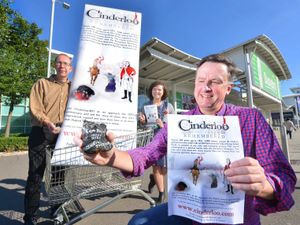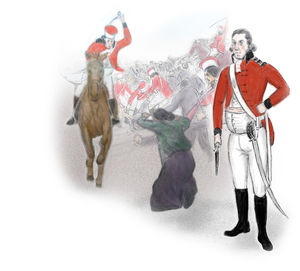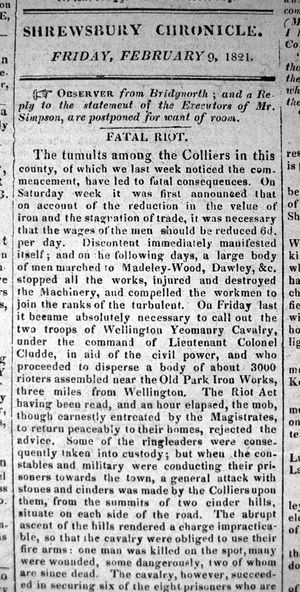The riot that Telford forgot: New group trying to raise awareness of Cinderloo uprising
When 3,000 men and women marched through what is now Telford to protest a major cut in pay, they could have had no idea the death and injury that was to come.

The workers came from mining towns across the region, discussing their plans in pubs and passing the word from community to community.
But when they gathered near to the current Forge Retail Park, the Shropshire Yeomanry were waiting for them.
The 1821 Cinderloo Uprising is a working class story rarely told in Shropshire, despite it changing the course of the area's history.
And nearly 200 years on, a new group is looking to mark the struggle of those who risked everything for a fair wage.
Brutality
Pete Jackson, member of the Cinderloo 1821 committee, said that the story runs contrary to the way we sometimes look at Victorian life in the area.
"This story highlights the conditions that working people were living in in that time," he said.
"It highlights the brutality of the conditions they were working in. It goes counter to the image that the Ironbridge museums present of a fairly twee existence in Victorian times of people hop, skip and jumping around and baking bread and all being happy.

"Actually people from a very young age – some as young as six, girls from 13 – were working 14 to 18 hours a day doing very hard physical work.
"We have the idea of the Iron Bridge, of the Darbys, of the Ironwork owners being innovative with their technology, but the price that people paid for that was to work in conditions that were brutal.
"The idea that people weren't going along with that and weren't thinking how wonderful it all was doesn't go along with the narrative of Telford as it is now."
Pay drop
The local ironmasters made an illegal pact to lower all their workers' wages by 6d – or about £1.20 in today's money.
It was their sudden and significant pay drop that riled up the miners and colliery workers, and led to them marching through the town in February 1821.
Magistrate Thomas Eyton read them the riot act and gave them an hour to leave, but the marchers, armed with tools and sticks, were having none of it.

The Shropshire Yeomanry, a regiment of the army, was ordered to advance and disperse or arrest the troublemakers.
But while they tried to make their arrests, the crowd started throwing stones and slag. Those captured were set free and, in the panic, the Yeomanry started shooting.
William Bird, an eighteen-year-old collier from Coalpit Bank was killed outright, while Thomas Gittins was mortally wounded.
Death warrant
Tom Palin, a collieryman from Hollinswood, was also shot. He went to his doctors to get the wound treated, but in doing so signed his own death warrant.
"They only found out about him being involved because he went to his doctor in Donnington," Pete said.
"The doctor told the story to someone else who thought it was evidence he was there.

"We think he was about 24. He could have been working down the pits for 16 years before his death. He was hanged in Shrewsbury. Before they put the noose around his neck, someone shouted 'farewell Tom'.
"He hanged for five minutes before he died. He's buried in Shifnal, and it's interesting to know that the vicar of the time allowed someone who was executed to be buried there."
After the uprising, most ironmasters agreed to "just" reduce the pay by 4d.
But it had a longer lasting impact on the area.
The discontent got more people talking about trade unions, about other events across the country.
And Methodist preachers arrived in Telford from Stoke and other nearby towns, helping the working class to find comfort from their hard lives through God.
Under siege
"This was a whole community that saw itself under siege," Pete said.
"These people had a hard existence. The women were part of the crowd, and young children were there as well. They were as raucous as the men. The crowd thought it had nothing else to lose."
It's only a little more than two years until the 200th anniversary of the Cinderloo uprising, and the Cinderloo 1821 group wants to change the often ignored period of local history.
They want to speak with children about the time period, highlighting both the historical events and how it impacts on the future.
But the group is also looking to mark the event, to find some way to remember those who died and fought.
"Tom Palin was just standing up for his mates, for the rights of people," Pete said. "There's a social justice angle about people standing up for what they believe in.
"This is a story for the future as well as the past. It's about the sense of community and the power they have when they work together.
"We want to involve as many people to raise awareness about the story. There's lot of creative ideas about what we can do.
"There's the idea of following the route the guys would have followed, there's the idea of doing artwork, and we want to make sure there's something that's left. At Forge Retail Park the only acknowledgement that this might have been industrial land is the name.
"There's no record of the Cinderloo uprising. We want to remind people that this is an event that took place and that we should be proud and learn from it."
For more information about Cinderloo or about the group visit cinderloo.com





